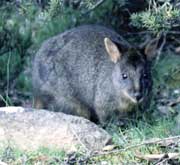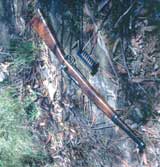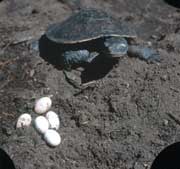Ferals, conservation and the shooter
by Ric Tester
Australian Shooter July 2001
Ric Tester is active in several shooting disciplines and is a keen conservationist. He is a member of WIRES (Wildlife Injuries and Rescue Information Service) and is an authority on Australian freshwater turtles.
 Some animal welfare groups and animal liberationist have, and do, hold shooters in contempt, citing their activities as cruel and detrimental to the environment. This misconception has resulted in much confusion and debate in the broader community, often resulting in viewpoints based upon perceptions, the ethics of which have not been fully clarified or unpacked. This article deals with the environmental issues that have arisen as a consequence of our ‘feral problem’ and the very useful role that the recreational shooter can play in the whole drama. In order to gain a full appreciation of the problem, it is necessary to understand the nature, behaviour and impact of our most serious feral pests.
Some animal welfare groups and animal liberationist have, and do, hold shooters in contempt, citing their activities as cruel and detrimental to the environment. This misconception has resulted in much confusion and debate in the broader community, often resulting in viewpoints based upon perceptions, the ethics of which have not been fully clarified or unpacked. This article deals with the environmental issues that have arisen as a consequence of our ‘feral problem’ and the very useful role that the recreational shooter can play in the whole drama. In order to gain a full appreciation of the problem, it is necessary to understand the nature, behaviour and impact of our most serious feral pests.
The European red fox
Almost 150 years ago, a small number of European red foxes were released into the bush near Melbourne. Well suited to the environment and with a copious food supply consisting mainly of small native mammals and large quantities of native reptile eggs, the population flourished and by the turn of the century had spread to all states with the exception of Tasmania. Before federation, the fox had officially been declared a pest in Victoria and NSW. Today, this vermin infests most of mainland Australia - perhaps with the exception of the tropical far north, the climate of which appears to be unfavourable to the animal. Foxes have successfully adapted to most habitats, including urban areas, but are most abundant in light to medium wooded areas and agricultural regions, where a food supply is most accessible.
Research has shown the fox to be one of Australia’s most successful and destructive introduced species. The sharp decline in populations of the Murray River turtle in NSW has been attributed almost exclusively to the fact that between 90 and 95 per cent of freshly laid eggs are consumed by marauding foxes. Mammals such as the numbat and the black flanked rock wallaby are running the risk of becoming extinct as a direct consequence of fox predation. The economic impact of the fox is substantial, as it preys on newborn lambs and goat kids. It is also a potential carrier of the disease rabies, which if ever introduced would be very difficult to manage.
At present, control is affected by placing poisoned baits (using poison 1080), trapping and shooting. Regrettably, placing baits can result in the inadvertent poisoning of non-target species.
Wild pigs
The wild pig population in Australia owes it existence to small numbers of animals that were brought to Australia as food supplies shortly after European settlement. It is probable that escaped animals soon established themselves anywhere where conditions were favourable - most frequently in areas with good supplies of surface water. Pigs are widely distributed in Victoria, NSW, Queensland, the Northern Territory and the northern parts of Western Australia, but are uncommon in the drier regions of the continent. Highly disruptive to the ecological balance, pigs are responsible for habitat destruction by virtue of the soil erosion caused by their frequent wallowing close to the edges of waterways and their constant foraging for food. They have destroyed nesting places for several species of wetland birds in areas where they occur. A major agricultural nuisance, pigs are destructive to crops and fences and will kill and eat young lambs with fearsome voracity. Pigs are carriers of the dreaded foot-and-mouth disease, which could virtually ruin the livestock industry of a country if allowed to spread. Current methods of control include shooting and poisoning, but the populations are remarkably resilient - sometimes regenerating at a rate of 80 to 110 per cent per annum in regions that facilitate their propagation.
 Feral goats
Feral goats
Goats were brought to Australia in the early days of settlement as a source of meat and milk. It is believed that small numbers were released on the Australian mainland in order to provide emergency food supplies for sailors. Herds soon became established - generally in mountainous or hilly areas. Today they inhabit western NSW, South Australia, Western Australia and Queensland. Goats are herbivores (ie, their diet consists exclusively of vegetation), but they, like the foxes and pigs, have had a marked effect on the population densities of other species. They compete with native species for food and shelter and in many cases the excavations caused by their hard hooves has destroyed the habitats of rock wallabies and other marsupials, which have subsequently disappeared from previously inhabitable areas. Feral goats will graze upon just about any vegetation, leaving in their wake a barren and desolate wilderness. A problem in the control of goats stems from the fact that many of the large populations exist in very remote areas and sometimes shooting from a helicopter is the only means of effective control.
Feral cats
Colonies of feral cats have existed since the middle of the 19th century - a situation that was unfortunately intensified by the deliberate release of large numbers of individuals in the hope that they would control rabbit populations, which themselves had reached epidemic proportions by the turn of the century. Today, these wild cats are so firmly ensconced as to practically deny eradication. Their presence in urban bushland (largely the result of the dumping of unwanted pets) constitutes a major environmental crisis. Cats are superb hunting machines that will thrive on small mammals, reptiles, birds and even insects. Cats are known to have caused the extinction of a sub-species of the red fronted parakeet on Macquarie Island.
Rabbits
The European rabbit is one of the most populous and familiar species of animal pests to have been transported to this country. Originally brought out on the first fleet and subsequently released deliberately in Victoria in 1859, the rabbit soon spread throughout NSW and Queensland and subsequently became one of the country’s most despised imports. Rabbits are not so much predators, but highly successful competitors - they have stolen food and shelter from native species and have had a particular impact on the small mammals that dwell in the ground in semi-desert areas. An expensive commercial pest, the rabbit denudes the land of vegetation, which has a dramatic effect on the quality of grazing land and is a major cause of erosion.
The rabbit virus myxomatosis was introduced in 1950 in an attempt to control rabbit populations - fleas being used as carriers. Initially, the strategy appeared to be successful, with more than 90 per cent of rabbits that caught the virus dying, but subsequent generations have developed a limited resistance to the disease, resulting in a latter-day population surge. As a further measure for biological control, the government has recently sanctioned the use of Rabbit Calicivirus Disease (RCD). This has an advantage over myxomatosis in that it does not need the flea to act as a vector for the transfer of the disease; it will spread directly between individuals living in close quarters. Current research centres on introducing diseases that will reduce the fertility of the adult population. This ‘immuno-contraception’ is still largely in the research and development phase.
 The role of the recreational shooter
The role of the recreational shooter
Management of vertebrate pests is a complex and involved endeavour. While it is true that much of the vermin control occurs at the ‘professional’ level (trained marksmen and women shooting from helicopters), the recreational shooter can make an important contribution to preserving Australia’s native fauna and protecting its economic resources.
In the current climate of strict gun laws, it is gratifying to see that ‘pest control’ still counts as a ‘genuine reason’ for owning a firearm and is in fact the primary reason why many shooters enter the sport. For the most part, landowners are welcoming to responsible shooters who, exercising due care for property and livestock, will hunt and kill feral animals while assisting in restoring an ecological balance to the land.
The Hunting and Conservation Branch of the SSAA - active in SA, NSW, WA, NT and Queensland - is a well-established group that deals with the eradication of pest species through organised hunting trips, regular meetings and educational programs. The branch also conducts courses in order to accredit new hunters by familiarising them with the protocols, rules and regulations of the group’s operations. The H&C group works in conjunction with the administrators of some national parks in organising culls; its efforts are aimed towards the control and eventual eradication of ferals within the parks. Partaking in organised activities such as culls is a demonstration of conservation in practice.
Firearms used in pest control
Naturally, the choice of rifle will be dictated by the target species. Opinions will vary on selection of calibre and so the recommendations that follow should merely be viewed as a guide.
Thousands of rabbits are taken annually with .22 calibre rimfire rifles - with or without telescopic sights - as the shooting distances are comparatively short.
Foxhunters may choose a .22 magnum or even a .222 or .223 - all accurate medium-range calibres to be employed when a longer shot at a small target is the norm. A telescopic sight with as much light gathering capacity as can be afforded should be employed when hunting for foxes. Feral cats would also be fitting game for these smaller calibres.
Goats are generally taken at a distance, with shooters generally preferring either the .243 or one of the .30 calibre rifles. I have, in the past, used a Winchester model 70 XTR in .300 magnum, fitted with a Leupold fixed power 6X scope. This is a very effective outfit for long shots.
Pig shooters use a variety of rifles for their hunting. Brush-busting lever action carbines in .44 magnum or the Marlin .444 have proved to be effective in stopping these thick-skinned animals. Thirty calibre rifles, loaded with heavy bullets, are also quite suitable for pig shooting, with large numbers of shooters using ex-military rifles for this purpose. There are some who even use a 300-grain projectile launched out of a .458 magnum to bring down some of the large boars.
 How can we help?
How can we help?
It is a sad irony that the Australian continent, geographically isolated and supporting an array of unique wildlife that could have only evolved in the absence of predators, has now come under siege and is in danger of losing its natural treasures. With past carelessness, neglect and mis-management all telling their sad tales and having left their legacies, it is now critical that in order to preserve our future we must not only be aware of the fragility of our environment but must be prepared to safeguard it. With the ever-increasing flow of human traffic through our country’s gateways and with the almost weekly reporting in the mainstream media of some new feral pest, our responsibilities must be clearly identified and we must share ownership of the problem.
Shooters are in a privileged position in the community by virtue of the fact that given certain restrictions, they are able to make a positive contribution towards conserving our natural wildlife.
I am a member of a large animal welfare group in NSW and have rescued dozens of native animals, many of which have been injured by predators. Rehabilitation in preparation for release may take months or may never occur, in which case the animal needs to be euthanased.
It is tragic that legions of so-called ‘animal lovers’ will release an unwanted cat that has passed its use-by-date as a cuddly plaything (and has reached its true potential as a killer) into the wild, setting it free on its daily path of environmental terrorism. For every cat, fox or other feral shot, many natives will live to reproduce and flourish. Responsible hunting is a tremendous asset to our conservation efforts and should be actively encouraged, for as the old cliché goes, ‘our future depends upon it’.
For information on how to become a member of the SSAA Hunting and Conservation Branch, please ring your state office.
